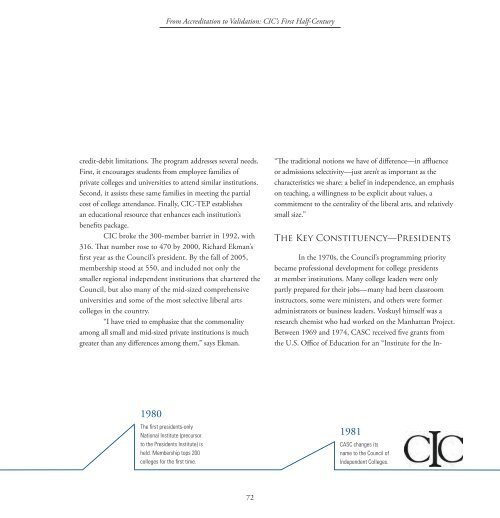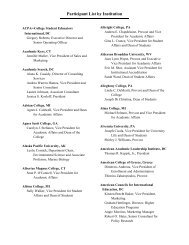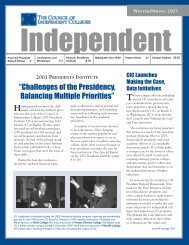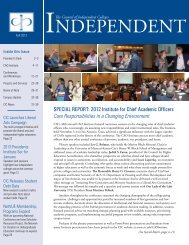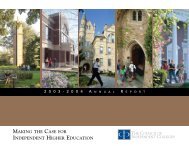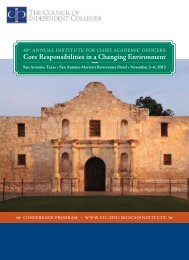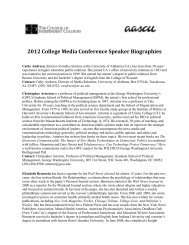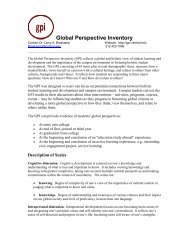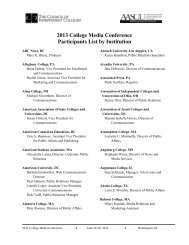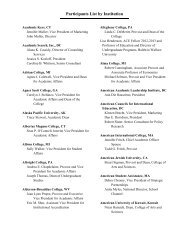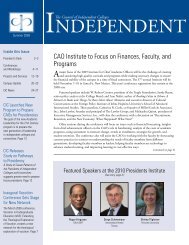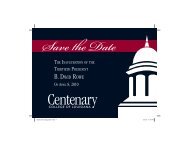Meeting the Challenge: - The Council of Independent Colleges
Meeting the Challenge: - The Council of Independent Colleges
Meeting the Challenge: - The Council of Independent Colleges
You also want an ePaper? Increase the reach of your titles
YUMPU automatically turns print PDFs into web optimized ePapers that Google loves.
From Accreditation to Validation: CIC’s First Half-Century<br />
credit-debit limitations. <strong>The</strong> program addresses several needs.<br />
First, it encourages students from employee families <strong>of</strong><br />
private colleges and universities to attend similar institutions.<br />
Second, it assists <strong>the</strong>se same families in meeting <strong>the</strong> partial<br />
cost <strong>of</strong> college attendance. Finally, CIC-TEP establishes<br />
an educational resource that enhances each institution’s<br />
benefits package.<br />
CIC broke <strong>the</strong> 300-member barrier in 1992, with<br />
316. That number rose to 470 by 2000, Richard Ekman’s<br />
first year as <strong>the</strong> <strong>Council</strong>’s president. By <strong>the</strong> fall <strong>of</strong> 2005,<br />
membership stood at 550, and included not only <strong>the</strong><br />
smaller regional independent institutions that chartered <strong>the</strong><br />
<strong>Council</strong>, but also many <strong>of</strong> <strong>the</strong> mid-sized comprehensive<br />
universities and some <strong>of</strong> <strong>the</strong> most selective liberal arts<br />
colleges in <strong>the</strong> country.<br />
“I have tried to emphasize that <strong>the</strong> commonality<br />
among all small and mid-sized private institutions is much<br />
greater than any differences among <strong>the</strong>m,” says Ekman.<br />
“<strong>The</strong> traditional notions we have <strong>of</strong> difference—in affluence<br />
or admissions selectivity—just aren’t as important as <strong>the</strong><br />
characteristics we share: a belief in independence, an emphasis<br />
on teaching, a willingness to be explicit about values, a<br />
commitment to <strong>the</strong> centrality <strong>of</strong> <strong>the</strong> liberal arts, and relatively<br />
small size.”<br />
<strong>The</strong> Key Constituency—Presidents<br />
In <strong>the</strong> 1970s, <strong>the</strong> <strong>Council</strong>’s programming priority<br />
became pr<strong>of</strong>essional development for college presidents<br />
at member institutions. Many college leaders were only<br />
partly prepared for <strong>the</strong>ir jobs—many had been classroom<br />
instructors, some were ministers, and o<strong>the</strong>rs were former<br />
administrators or business leaders. Voskuyl himself was a<br />
research chemist who had worked on <strong>the</strong> Manhattan Project.<br />
Between 1969 and 1974, CASC received five grants from<br />
<strong>the</strong> U.S. Office <strong>of</strong> Education for an “Institute for <strong>the</strong> In-<br />
1980<br />
<strong>The</strong> first presidents-only<br />
National Institute (precursor<br />
to <strong>the</strong> Presidents Institute) is<br />
held. Membership tops 200<br />
colleges for <strong>the</strong> first time.<br />
1981<br />
CASC changes its<br />
name to <strong>the</strong> <strong>Council</strong> <strong>of</strong><br />
<strong>Independent</strong> <strong>Colleges</strong>.<br />
72


